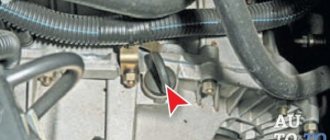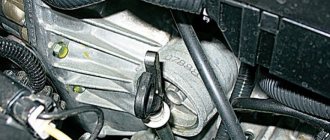Kia Rio 3 is a compact car located in the same class as Lada Vesta and Volkswagen Polo. Another closest competitor is the Hyundai Solaris, on the basis of which the 3rd generation Rio was built. The machine went into production in 2011 at a plant in St. Petersburg. The sedan and hatchback of the same name had a common design with the Solaris, but were noticeably different in exterior and interior design.
The engine range included 1.4 and 1.6 liter petrol engines, operating with a 5-speed manual transmission or a 4-speed automatic. A six-speed automatic transmission was also available for the 1.6 engine, which began to be offered after the 2015 restyling. In addition, the restyled model received updated head optics, improved bumpers and radiator grille, and LEDs were built into the taillights. In the cabin, the steering wheel and air conditioning system have been updated. The third generation Kia Rio was released until 2022.
What manual transmission is on the Kia Rio 3
The third generation Kia Rio was equipped with a six-speed manual gearbox Hyundai M6CF1, which appeared in 2010 and replaced the five-speed M5CF1 gearbox. This gearbox model is installed on a large number of Kia and Hyundai models with front-wheel drive and a transverse internal combustion engine. Before us is a classic two-shaft transmission unit with cable drive. The design of the Hyundai M6CF1 also provides double-cone synchronizers in the first three gears, and single-cone synchronizers are used in the remaining gears.
Disadvantages and cost of the M6CF1 box
- leakage along the input shaft oil seal, as a result of which the leak spreads to the driven clutch disc, which can cause slipping. To replace this seal, you will have to completely disassemble the box.
- low clutch reliability in harsh conditions, although the resource of this unit can reach up to 100 thousand kilometers, and the release bearing has a much shorter service life
- bearing humming may be associated with active use in city traffic jams or off-road. The component can hum at 150 thousand km, but in a gentle mode of use their resource can reach 250 thousand
- lubricant leaks through the wires, and this is especially true for gearboxes in the first years of production of the Kia Rio 3. A recall campaign was still carried out regarding this issue. It affected cars with manual transmission, and the defect was corrosion of the input shaft
- The gearbox drive requires periodic adjustment
- The service life of the M6CF1 box is 180 thousand km, and its cost on the secondary market ranges from 25 to 60 thousand rubles. For a contract version abroad they ask for 500 euros, and the cost of a new product is 75 thousand rubles.
What gearbox is installed
The basic versions of the 4th generation Kia Rio are equipped with a six-speed manual M6CF1, which replaced the five-speed M5CF1 transmission. The transmission went into production in 2010 and first became available on the third generation Rio. The M6CF1 gearbox is installed in compact and mid-class Hyundai-Kia cars. The new gearbox is a classic two-shaft gearbox with cable drive. In addition, the M6CF1 design includes double-cone synchronizers in the first three gears, as well as single-cone synchronizers in the remaining gears.
Characteristics of Hyundai M6CF1
Type – six-speed mechanical Purpose – for engines with torque up to 170 N/m Service life – 250 thousand km
Advantages of Hyundai M6CF1
- proven design and high maintainability
- availability of spare parts
- no problems finding a donor on the secondary market
Disadvantages of Hyundai M6CF1
- With high mileage, there is a high probability of leaks at the seals
- low reliability of clutch components
- timely adjustment of the cable drive is required
- possible humming of bearings at 200 thousand km
Cost of Hyundai M6CF1
On the secondary:
Minimum price – 25 thousand rubles Maximum price – 60 thousand rubles Average price – 35 thousand rubles
In the shop:
The price of the new unit is 75 thousand rubles
Abroad:
The price of a contract gearbox abroad is 500 euros.
Recommended oil
As with the engine, three types of oils can be recommended for the Kia Rio's gearbox.
| 1. Synthetic is the best oil today due to its high fluidity. The fluid is quite rare and quickly lubricates transmission parts, and is also practically not prone to freezing at low temperatures. Based on this, synthetics can be recommended not only for summer, but also for harsh winter use. |
| 2. Mineral is one of the cheapest gear oils, since it is the complete opposite of synthetics. This composition has too thick a consistency and is prone to hardening even at not the lowest temperatures. In this regard, problems with the clarity of gear shifting cannot be ruled out, and interruptions in starting the engine may also occur. Therefore, mineral liquid is strictly not recommended for winter operating conditions. This oil is used mainly by owners of old cars, and in the case of the Kia Rio 3, only the most economical owners of such cars from the first years of production may prefer it. |
| 3. Semi-synthetic - the golden mean between synthetics and mineral water, since such oil is produced with the addition of two types of liquid - synthetics and mineral water. And yet, there is much more mineral oil in semi-synthetics. Based on this, it is not surprising that semi-synthetics should also not be used at extremely low temperatures. However, the quality of such oil is significantly superior to ordinary mineral water, but semi-synthetic is also recommended for owners of Rio in the first years of production |
Based on the above, we can conclude that the optimal oil for Kia Rio with a manual transmission is synthetic oil. It can be used for cars after 2013, while owners of older models may well save on purchasing semi-synthetics.
In addition to the type of oil, when choosing a suitable fluid for a Kia Rio manual transmission, you also need to take into account other equally important parameters.
- Among them, API-GL4 approval is important, which is suitable for most manual transmissions. It will be enough for Kia Rio.
- Another important parameter is oil viscosity. So, for winter operation, a viscosity of SAE 70W, 75W-, 80W or 85W is suitable, while in summer it is better to use SAE 90, 140 or 250. For year-round use, you can opt for oil SAE 75W-80, 80W-85, 85W-90, 75W-90 or 80W-90.
The recommended oil for the manual transmission of the Kia Rio 3 is Hyundai-Kia MTF 75W-90 GL-4 , created specifically for manual transmissions. In addition, an alternative oil for the Hyundai M6CF1 6-speed gearbox is SAE 75W-85 API-GL-4 fluid with specification TGO-7 (MS517-14).
About Hyundai MTF 75W-90 oil
Hyundai MTF 75W-90 is an original transmission fluid for manual transmissions of cars produced by Hyundai and Kia. This oil can also be used to lubricate transfer transmissions and steering gearboxes. The oil is developed by Mobis, part of the Hyundai Corporation, and Hyundai MTF 75W-90 is produced by Michang, SK Lubricants and S-Oil Total Lubricants. This lubricant contains antioxidant, anti-corrosion and anti-wear additives that ensure smooth operation of the gearbox and smooth gear shifting without any jerking or jerking. At the same time, the original characteristics of the gearbox and the oil itself do not deteriorate and are maintained until its next scheduled replacement.
It is recommended to purchase original all-season Hyundai MTF 75W-90 oil only from official dealers or certified stores, including online stores. The lubricant is sold in blue plastic cans, the volume of which can vary from 1 to 6 liters. At the same time, each volume has its own article number:
- Liter canister – article number 043005L1A0
- Six-liter canister – article number 043005L6A0
The average cost of one liter of transmission fluid is 500 rubles, and a six-liter container will cost 2500-2800 rubles, depending on the region and store.
Characteristics of Hyundai MTF 75W-90 GL-4
- Type – synthetic
- Viscosity – 75W-90
- Color – amber
- Pour point – minus 42 degrees
- Density at 15 degrees – 899 kg/cubic. m
Car enthusiasts' choice
Mobil SHC 75W-90
1.Mobil SHC 75W-90 is a transmission fluid for powerful gasoline engines that are subjected to heavy loads. Suitable for Kia Rio 4. The fluid contains a pure synthetic base and is recommended for manual transmissions that are compatible with API specifications MT-1, GL-4 and GL-5.
Due to its moderate extreme pressure properties, this lubricant can be used specifically for extreme driving. The Mobil product is universal in use, as it is suitable for trucks, as well as agricultural vehicles and special equipment in the mining industry.
Benefits of Mobil SHC 75W-90
- a set of modern additives with a long service life
- reliable protection of gearboxes subject to maximum loads
- preservation of the beneficial properties of the oil in a wide temperature range, as well as at high pressure
- resistance to oxidation and corrosion
- practically not prone to freezing, since freezing occurs at minus 54 degrees
- stable viscosity and fluidity, as well as efficient cold starting
- fast and uniform pumping over the entire surface of the gearbox
- protection of parts from premature and skidding already when starting the engine
- fuel savings and increased oil change intervals
Characteristics of Mobil 1 SHC
- SAE classification – 75W-90
- Density at 15 g. – 0.87 kg/l
- Flash point – 202 degrees.
- Kinematic viscosity at 100 g. – 15.1 sq. mm/s
- Kinematic viscosity at 40 deg. – 102 sq. mm/s
- Pour point – minus 54 degrees.
- Viscosity index – 156
- Requirements: API-GL-5/MT-1, ZF TE-ML 07A, Bosh TE-ML 08, ZF TE-ML 08, AIP-GL-4
- Approvals: Autodiesel, Man, MB-Approval 235.8, ZF TE-ML, SAE J2360
Release form and articles
- 1 l – 152659
- 1 l – 142123
- 20 l – 152738
- 20 l – 123716
- 208 l – 152576
- 1000 l – 115516A
Lukoil TM-5
2.Lukoil TM-5 - oil from a monopolist on the Russian market in the field of auto chemicals. Moreover, today Lukoil has production facilities not only in Russia, but also in European countries. This confirms the high quality of Lukoil products, despite their low cost.
This is especially true for the TM-5 line, which is produced on a semi-synthetic basis and at the same time has good technical characteristics. After all, this oil is based on basic mineral and synthetic compounds, improved by adding imported additives used for the production of famous foreign oils. Lukoil TM-5 is recommended for Russian and foreign cars, suitable for any mechanical transmissions, including hypoid and transfer cases, differentials, and steering mechanisms.
Thus, we have before us a universal and inexpensive liquid, which is not suitable except for use in synchronizers made of non-ferrous metals.
Advantages of Lukoil TM-5
- a set of effective foreign-made additives
- high level of extreme pressure properties with wear protection
- the oil ensures smooth gear shifting thanks to a durable oil film, which eliminates the effect of dry friction and damage to parts
- possibility of operation in a wide temperature range for a long time
- reliable anti-corrosion protection
- no foam or oxidation
- fuel efficiency
- optimal replacement interval
Characteristics of Lukoil TM-5
- Density at 15 g. – 884.1
- Kinematic viscosity at 100 g. – 16.1 sq. mm/s
- Dynamic viscosity at minus 40 deg. – 101,078 mPa*s
- Viscosity index – 179
- Flash/pour point – 179/minus 44 degrees.
- Scuff index – 560 N
- Welding load – 3687 N
- Wear indicator - 0.87 mm
- Foaming at 24/94 deg. – 0/10 ml
- Foaming at 24 degrees. after testing at 94 degrees. – 0/0 ml
- Approval – AvtoVAZ
- Approvals – API-GL-5, MIL-L-2105D
Release form and articles
- 1 l – 19543
- 4 l – 19545
- 50 l – 19547
- 17775 – 216.5 l
Castrol Syntrans Transaxle
3.Castrol Syntrans Transaxle - oil from a leading manufacturer in the automotive chemicals and fuels and lubricants market. The company's products have a wide range with a different set of characteristics suitable for specific use and driving style. Thus, the Syntrans Transaxle line is the optimal choice for the six-speed manual Kia Rio 4, because we have pure synthetics with the ideal combination of performance properties.
It is an indispensable tool for maintaining stable operation of the transmission under both gentle and heavy loads. In addition to manual transmissions, it is also suitable for transmissions in the block with the final drive of the front drive axle, as well as for transfer cases. Has approvals from leading brands such as Volkswagen.
Advantages of Castrol Syntrans Transaxle 75W-90 (formerly TAF-X 75W-90)
- increased level of anti-wear and antioxidant properties
- a special set of additives helps protect against corrosion and dirt deposits
- uninterrupted operation of the transmission over a wide temperature range
- efficient cold start thanks to extremely low pour point
- Multi-layer protective film provides powerful protection of parts against dry friction
Characteristics of Castrol Syntrans Transaxle
- Density at 15 g. – 0.866 g/ml
- Kinematic viscosity at 100 g. – 14.8 sq. mm/s
- Kinematic viscosity at 40 deg. – 78 sq. mm/s
- Brookfield viscosity at minus 40 deg. – less than 50000 mPa*s (cP)
- Viscosity index – 195
- Flash/pour point – 210/minus 54 degrees.
- Approvals: API GL-4; GL-5, Volkswagen 501.50
Release form and articles
- 1 l – 1557C3
- 20 l – 1557С5
- 60 l – 1557С4 – 60 l
- 208 l – 15804D
Toyota Gear Oil
4.Toyota Gear Oil is a highly effective synthetic oil from the famous Japanese concern, which has a large division producing a range of lubricants suitable for both Toyota cars and cars of other brands. Transmission fluid from the Gear Oil line is universal and compatible with many modern models, including the Kia Rio. The specifications of this oil are fully compatible with Korean six-speed manual transmission. In general, the Gear Oil series is suitable for most transmissions with the exception of transmissions made using bronze and brass alloys.
Benefits of Toyota Gear Oil
- optimal viscosity and fluidity
- no foaming
- improved fuel efficiency
- protection against oxidation products and corrosive effects due to stable additives
- ensures smooth and quiet operation of the gearbox, including during sharp shifts
- promotes effective cooling of parts and prevents their wear ahead of time
- forms a durable oil film that eliminates the effect of dry friction until the next scheduled oil change
Characteristics of Toyota Gear Oil
- Kinematic viscosity at 40 deg. – 74.86
- Kinematic viscosity at 100 g. – 14.25
- Density at 15 g. – 0.891
- Flash/pour point – 165/minus 32 degrees.
- Phosphorus composition – 900
- Approvals: API GL-5, API-GL-4
Articles and release form
- iron can 1 l – 08885-02106
- plastic jar 1 l – 08885-80606
- iron bucket 20 l – 08885-02103
Mobil Mobilube GX 80W-90
5.Mobil Mobilube GX 80W-90 - oil from a well-known American company that promotes a specialized GX line for use in severe road and climatic conditions. Thus, this liquid is already initially oriented towards high loads. Mobil Mobilube GX is suitable for transmissions that require GL-4 specification oil.
At the same time, compatibility is declared not only with passenger cars, but also with highway and commercial vehicles, including heavy trucks and special construction vehicles. Thus, we have before us a universal oil with a resource reserve, which in the case of the Kia Rio 4 will please you with a very long replacement interval.
Benefits of Mobil Mobilube GX
- long replacement interval
- protection against increased wear under heavy loads thanks to effective beneficial properties
- protection against corrosion, oxidation products and dirt deposits
- absence of soot, rust and foam throughout the entire interval until the next oil change
- low probability of leaks
- increasing the durability of bearings and gears
- compatibility with different seals
- resistance to sudden temperature changes over a wide range
Characteristics of Mobil Mobilube GX
- Viscosity SAE – 80W-90
- Kinematic viscosity at 40 deg. – 135
- Kinematic viscosity at 100 g. – 14.5
- Viscosity index – 104
- Flash/pour point – 240 minus 33 degrees.
- Density at 15 g. – 0.89 kg/l
- Approvals: API-GL-4
Articles and release form
- 1 l – 152660
- 20 l – 153052
- 208 l – 153046
Under what conditions should you change the oil in advance?
In Russia, most car manufacturers and official service stations recommend promptly changing the oil in a manual transmission, especially if the car is subjected to heavy loads for most of its operation. We are talking about sudden starts and braking, changes in throttle and active maneuvers in traffic light city traffic jams. Of course, too aggressive driving negatively affects the beneficial properties of the oil, which as a result becomes unusable much faster. Other severe operating modes of the vehicle include the following:
- transportation of heavy loads
- driving on broken roads
- Frequent towing of semi-trailers or vehicles
- variable climate and significant temperature changes
- wheel slipping on snowy or icy roads, as well as in mud
Under the above conditions, premature oil changes cannot be avoided in order to prevent major overhauls of the gearbox. After all, the cost of an oil change is much lower than such repairs. Thus, regularly updating the manual transmission oil will allow you to significantly save on maintenance.
Severe operating conditions:
- work in the commercial field and transportation of heavy loads with unacceptable weight
- work in the passenger sector and frequent transportation of large numbers of people
- towing trailers and cars
- constant operation in conditions with temperature changes (short-term predominance of too low and then high temperatures or vice versa)
- driving in traffic light jams with sudden starts and braking
- wheel slip on an icy road, on rough slushy terrain, etc.
- aggressive driving with sharp lane changes and high revs, as well as quick gear changes
When is the best time to check the oil?
Despite the fact that the average oil change schedule is 50-60 thousand km, it must be checked every 10 thousand km. Moreover, it is necessary not only to check the condition of the fluid and its level, but it also does not hurt to periodically look under the bottom and inspect it. If oil stains are detected, it is recommended to check the tightness of the gearbox seals, and it may also be necessary to replace the oil filler neck.
First signs to check and change the oil
- oil began to leak out spontaneously due to damage to the seals and gaskets
- the appearance of extraneous noise and hum in the transmission
- difficult gear shifts due to overheating and wear of the shift mechanism
- leaks due to loose crankcase mounting
- independent gear shifting
- problems with synchronizer or gears
How to check the oil level using the dipstick
- park the car on level ground
- pull out the dipstick, wipe it and insert it back into the socket
- pull it back out and determine the level
- oil is added if it is below the max mark
How to check oil when cold
Checking the oil level when it is cold is a conditional procedure, since even the use of modern devices requires mandatory warming up of the engine at subzero ambient temperatures. If it’s warm outside, then this method can be used without warming up the internal combustion engine. Checking the oil level when cold is carried out only on a level surface, since an inclined surface can distort the readings.
How to check the level using the control plug
- install the car on a lift or place it above the inspection hole
- wipe the inspection plug and use a special wrench to remove the inspection bolt
- after this, oil may leak if it exceeds the permissible level
- The oil level is considered normal if the liquid slightly wets the threads of the inspection window
- The oil level is considered insufficient if no lubricant is visible in the crankcase. In this case, you will need to add oil.
- after filling, replace the copper washer and return the screw back to its place
Oil condition: how to quickly check by color
- pink color is a sign of high concentration of water
- red color allows you to verify the high quality of the oil
- dark red color indicates slight wear and dirt
- brown color indicates heavy soiling and serious wear
- black color is a sign that the oil is completely outdated and is high time to change it
When to replace
First you need to check the condition of the oil - at least this must be done every 10 thousand km. It doesn’t hurt to inspect the bottom for oil stains, and also, if necessary, check the tightness of the manual transmission seals and oil filler gaskets.
Below are the timings for changing the oil in difficult conditions, as well as depending on the type of oil.
| 35-40 thousand km – for mineral oil |
| 45-50 thousand km - for semi-synthetics |
| 65-70 thousand km - for synthetics |
Of course, in Russian conditions it is quite difficult to maintain careful driving. And yet, if you try to stick to a leisurely drive and shift gears smoothly, then the oil change schedule for a manual transmission can be 30 thousand more than in more difficult transmission operating modes. But it is important to keep in mind that even in a gentle mode of use, the oil change period should not exceed 100 thousand kilometers or six years, whichever comes first.
Step-by-step instruction
1. We drive the car into the pit and dismantle the protection. The protection is secured with four bolts.
We unscrew the front two bolts under the seventeen head completely. We release the back two by about half. Next, we take it, move the protection towards the face of the car and remove it.
2. Remove the protective cover to gain access to the filler plug. The casing is secured with four ten socket head bolts.
3.After removing the casing, we got good access to the filler plug.
4. Unscrew the filler plug, the edges are seventeen. We unscrew the plug so that there is air leakage and the oil drains out faster.
5. Place a container to collect used oil and unscrew the drain plug. It is also turnkey for seventeen.
6. After the oil has completely come out, screw on and tighten the drain plug.
7. We draw oil into the syringe and put on a tube. Insert the tube into the filler hole and add oil. There will be 1.8 - 2 liters of oil.
Don't be afraid to overfill; if you overfill, it will simply flow through the filler hole.
8. Screw on and tighten the filler plug.
9. Wipe off any oil spills with a rag.
10. Install and secure the casing with four bolts.
11. Install and secure the engine protection with four bolts.
Replacement frequency
The manufacturer indicates that you need to check the oil level every 90 thousand kilometers and, if necessary, top up. They also write that the oil in a manual transmission is designed for its entire service life. Under operating conditions in the Russian Federation, the oil needs to be changed every 30-40 thousand kilometers. In this case, there will be no problems with the manual transmission, and it will take a very long time. There are examples when boxes on Rio 3 were maintained for more than 500 thousand km without repair.
Video lesson
Why change the oil in a manual transmission?
The need to change transmission oil can be explained by its main functions:
| 1. Lubricating – ensures minimization of dry friction between gears that are constantly interlocked. The result is smooth engagement and uniform wear of parts, as well as effective heat removal from rubbing components. In addition, the oil protects gearbox mechanisms from metal shavings, which act on the metal as an abrasive. |
| 2.The protective function of the oil should be understood as a special protective film that protects transmission parts from corrosion and oxidation processes so that the gearbox lasts as long as possible and without failures |
| 3.The cooling function of the oil maintains optimal temperature conditions inside the gearbox. The fact is that in critical operating conditions, the temperature at the point of gear engagement can reach 250 degrees. The temperature of good (not old) oil does not exceed 150 degrees, which means the parts give off excess heat to it and are thus cooled |
How to change oil
Changing the oil in a Kia Rio manual transmission will require a lift or inspection pit. In extreme cases, an overpass will do. You will need the following equipment:
- drain pan
- syringe
- funnel
- a set of wrenches or sockets with the required diameter for the drain and oil filler holes
- O-ring for oil filler hole
- transmission oil in a volume of two liters
Oil change steps
- In preparation for the procedure, turn on the engine to heat the oil to a liquid state so that it drains faster
- Place the car on a lift, turn off the engine and apply the handbrake
- Remove the engine protection, place a tray under the hole to drain the used oil.
- Unscrew the oil filler plug and pull out the dipstick to facilitate the draining process
- If necessary, install a new gasket
- Unscrew the drain plug on the box crankcase and drain the used oil into a pre-prepared pan
- The drained fluid should be transparent, and if there are any impurities, the gearbox will need diagnostics at a service center (this may be due to increased wear, overheating, etc.)
- After draining the old oil, screw the drain plug back in.
- Using a funnel, pour liquid into the oil filler hole to the required level, which can be controlled with a dipstick
- Return the dipstick back to its place and tighten the oil filler hole.
- They install the protection, start the car and drive several kilometers to check the gearbox over the entire gear range. This will distribute the oil throughout the entire transmission.
- Check the oil level and top up if necessary.
What are the signs for an oil change?
- no movement after shifting into gear
- extraneous noise
- difficult gear shift
- used oil has a burning smell and is dark in color
Partial oil change
During a partial oil change, 40-60% of the total volume of old fluid is drained, after which this missing volume is replaced with new oil.
Advantages and disadvantages of partial replacement
- Less oil required per refill
- minimal costs for replacement services
- There is practically no risk of breaking the gearbox mechanisms, since no deep intervention in the design of the gearbox is required
Complete oil change
When changing the oil completely, it is possible not only to completely remove the old fluid, but also to flush the unit, as well as replace all consumables. And only after that new fluid is poured in.
Benefits of a full replacement
- after a complete replacement, there are no remnants of the old fluid in the box, as well as any dirt deposits
- The performance of the gearbox is noticeably improved, gears engage smoothly and there are no jerks
- possible slight reduction in fuel consumption
Based on the above, we can conclude that for high mileage it is better to perform a complete oil change. The fact is that with a partial replacement, only 50% of the oil can be replaced, and the rest remains in the box along with mud deposits. In general, the process of changing oil in a manual transmission is not difficult compared to an automatic transmission. The mechanics do not have filters and therefore do not need to be changed.
Transmission oil parameters
In order to prevent premature mechanical wear of parts, leading engineers have developed special parameters - for example, standards for temperature viscosity, as well as quality classes. More viscous oil has additional additives, due to which it becomes better resistant to various negative climatic factors.
Article on the topic: When to change the oil in a Kia Rio gearbox
Interestingly, the composition of transmission oils is in many ways similar to motor oils. For example, transmission fluid has the same components that prevent the formation of rust and also prevent rapid wear of parts. The differences lie only in the ratio of the quantities of certain components.
Gear oil contains a complex of potent chemicals, including phosphorus, chlorine and sulfur. These components form a durable oil film that can withstand high pressure and mechanical stress.











